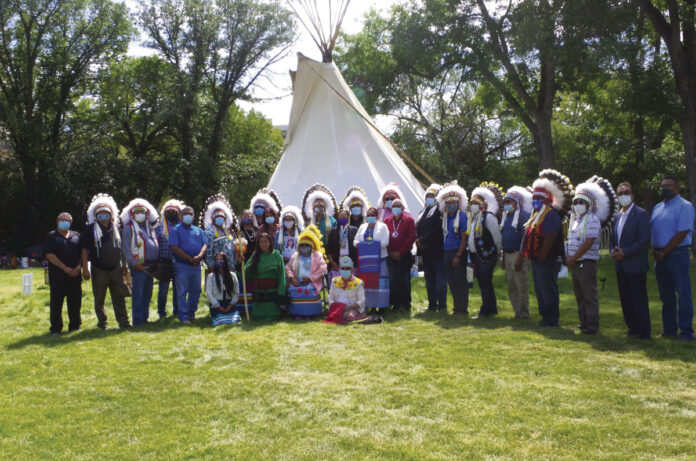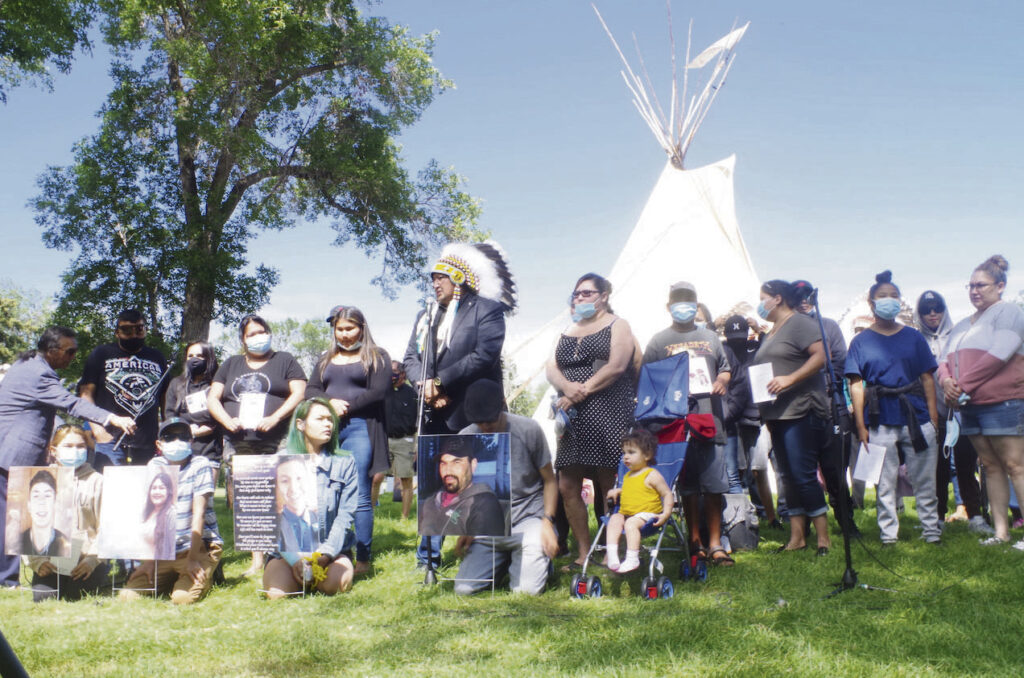
Peter Lozinski and Marjorie Roden
First Nations leaders and families from across Saskatchewan joined Tristen Durocher in Wascana Park Tuesday to offer their support to the fiddler’s 44-day ceremonial fast.
Durocher walked over 600 km from La Ronge to Regina before beginning a fast, first in protest, and now in ceremony. He took on the journey to call on the province to create a suicide prevention strategy. Durocher previously said that his protest ended the moment government ministers Lori Carr and Warren Kaeding left his tipi after reportedly “lecturing” him on their Pillars for Life plan and telling him they were filing for a court order.
Durocher’s 44-day fast is to mark each of the 44 votes against an NDP bill sponsored by Doyle Vermette calling for a suicide prevention strategy.
In place of a suicide prevention strategy, the provincial government has touted its framework, though critics aren’t convinced.
In May, a suicide prevention expert who has drafted multiple suicide prevention strategies told the Saskatoon StarPhoenix he was doubtful the plan would do anything to lower Saskatchewan’s high suicide rate.
He said the government’s strategy doesn’t have a clear path to implementation and sets goals that are “so vague as to be meaningless.”
“I am not confident this document will save lives,” Jack Hicks said.
The strategy was introduced by Minister for Rural and Remote Health Warren Kaeding, who said it’s based on material from the Mental Health Commission of Canada and a review of services in other jurisdictions.
It sets out a list of Year 1 goals based on five central pillars: specialized supports, training, awareness, research and reducing the potential for suicide in at-risk facilities like hospitals.
Hicks said it doesn’t get at the root of why Saskatchewan’s suicide rate, which was roughly double the national average in 2018, is so high in the first place.
Nor does it address the underlying reasons for high suicide rates among northern communities, Indigenous people or youth. The word “trauma” does not appear in the plan, which Hicks takes as a sign that First Nations and Métis concerns are not adequately represented. The document is only eight pages long, three of which are taken up by the bibliography and the introduction.
“The suicide rate for a young First Nations woman is about 30 times the national average in that demographic,” Hicks said. “That’s the kind of statistic that demands an explanation.”
When asked, Kaeding said the plan is more of a “starting point” than a fixed strategy, saying its progression could change over time. He noted suicide is a complex problem and acknowledged there is no “silver bullet” to solve it, but argued that if the plan “saves just one life, then it is worth it.”
He said the plan aims to serve the entire population, which is why it doesn’t discuss specific communities at length.
“Suicide is a provincial concern,” he said. “There is no one specific entity that we’re going to be able to fund along that line.”
Critics believe a law is preferable to a plan, arguing it would improve oversight. Kaeding has said the difference is negligible, would have the same result, but legislation is more complicated.
“If there was a way to legislate an end to suicide, this government would have certainly tried to do it,” he said.
Kaeding added that the province didn’t fund the FSIN’s suicide prevention strategy because “throwing money” at a plan was not a solution to the issue. When asked what the biggest existing gap in mental health services for rural and remote communities was, he said the main challenge is identifying when people need help.
That’s not what those gathered in Regina said on Tuesday, though.
“We could fill that lawn across the street with everyone who’s left us,” said Federation of Sovereign Indigenous Nations Chief Bobby Cameron.
“Your legislation, your suicide strategy is not going to work with us because you don’t have direction. You don’t have a recommendation from our people. So what we’re going to do is work with folks like Tristen and many others who are affected and hand them a bill based on our recommendations, our protocols, our traditions, our language and culture. Listen and take the direction directly from the people it’s affected. You’ll see positive results. That’s the message.”
Some of the most powerful comments Tuesday came from people who have been directly affected. Several residents of Fond du Lac made the trip. The northern First Nations community has lost several from suicide.
Victor McDonald lost his son. His firstborn was killed in 2006, he said, and then in 2017, his second son died by suicide.
“It pulls at my heart,” he said. “We’re not going to bury you, you’re going to bury me — that’s what my dad told me. These young people here, we need to have a future for them, not bury them. You gotta make some changes, big time, big time. In our community, there’s way too much suicide. It needs to change. We need some big changes and good help from the government.”
Another family member who lost a loved one to suicide also spoke. Sabrina Fern said she lost her husband in July. They have four kids — the youngest just turned one.
“It is a losing battle,” she said.
“The mental health offered up north is a laughing matter. It isn’t working for us.”
She said mental health workers come and go, and each time, those who are asking for help feel like they’re starting over from scratch. She asked what it will take for someone to take real action.
“You just want to give up. You don’t want to talk anymore. It’s not fair to the people that actually want to get help. Something better needs to be done for our people up north. If it’s money that’s not being properly provided, is this money? Their lives? Now I have to keep an eye on my kids all the time because they’re directly affected.”
She said more support is needed to battle issues such as isolation and mental health in the north.
“There are kids that need to leave their homes just to feel safe and that shouldn’t be happening. Everybody should have a safe place. I want to cry so bad but I want to remain strong for my kids to show them that I’m able to keep my head high and walk through this world with them.”

Fond du Lac Chief Louie Mercredi said that when the situation was at its worst, help arrived, but it was short-lived.
“Everyone that’s here with me has experienced the trauma of suicide,” he said.
“I lost two brothers-in-law. I lost a nephew to suicide. I lost my daughter’s boyfriend to suicide as well.”
“You can hear the stories and the words. I don’t have to say everything, but I’m sure the tone of my voice will explain the trauma that we face as First Nations people of Saskatchewan, throughout Canada.”
“When we’re faced with trauma, everyone wants to help. But there is no long-term solution for our people.”
He indicated the photos of those who had died by suicide on display near the tipi.
“These photos say it all. We need help.”
While Mercredi pleaded for help, others came to amplify the voice of Durocher.
“We come to lend him our voice. We come to help him acknowledge all of the pictures you see … that he has carried on his walk,” said Edmund Bellegarde, Tribal Chief and CEO File Hills Qu’Appelle Tribal Council Inc.
“Tristen shared with us the inequality, the frustration, why he walks, why he’s conducting this ceremony.”
He then had a message for decision-makers.
“There are many laws and policies that have been made across the street, that have been made in Ottawa. These laws and policies are stated to have been made for equality … but yet they have a disproportionate effect on the First Nations people, the Métis people, the Inuit people of Turtle Island.”
Tristen’s message, Bellegarde said, needs to be supported, acknowledged and amplified.
“Public policy in this country, laws and legislation needs to change. Ther are too many one-way streets in Canada. We need that two-way dialogue. We need to support the voices of our young people and the ceremony of this young man — It gives us hopes in our young people, their strength and their leadership.”
Despite applications for court orders, Durocher remains in Wascana Park. His fast is set to end on Sept. 13. Until then, he will sleep in his tipi and consume only tea with honey.
“I’ll leave on Sunday, September 13th a skinny pile of bones who showed Canada what Indigenous people are dealing with in this province,” Durocher wrote on Facebook Sunday.
“A political establishment with complete contempt for us and disregard for our lives and health. I will leave this place having given my full surrender to (the) Creator and to our ceremony of prayer.”
— with files from Zak Vescera, Saskatoon StarPhoenix

